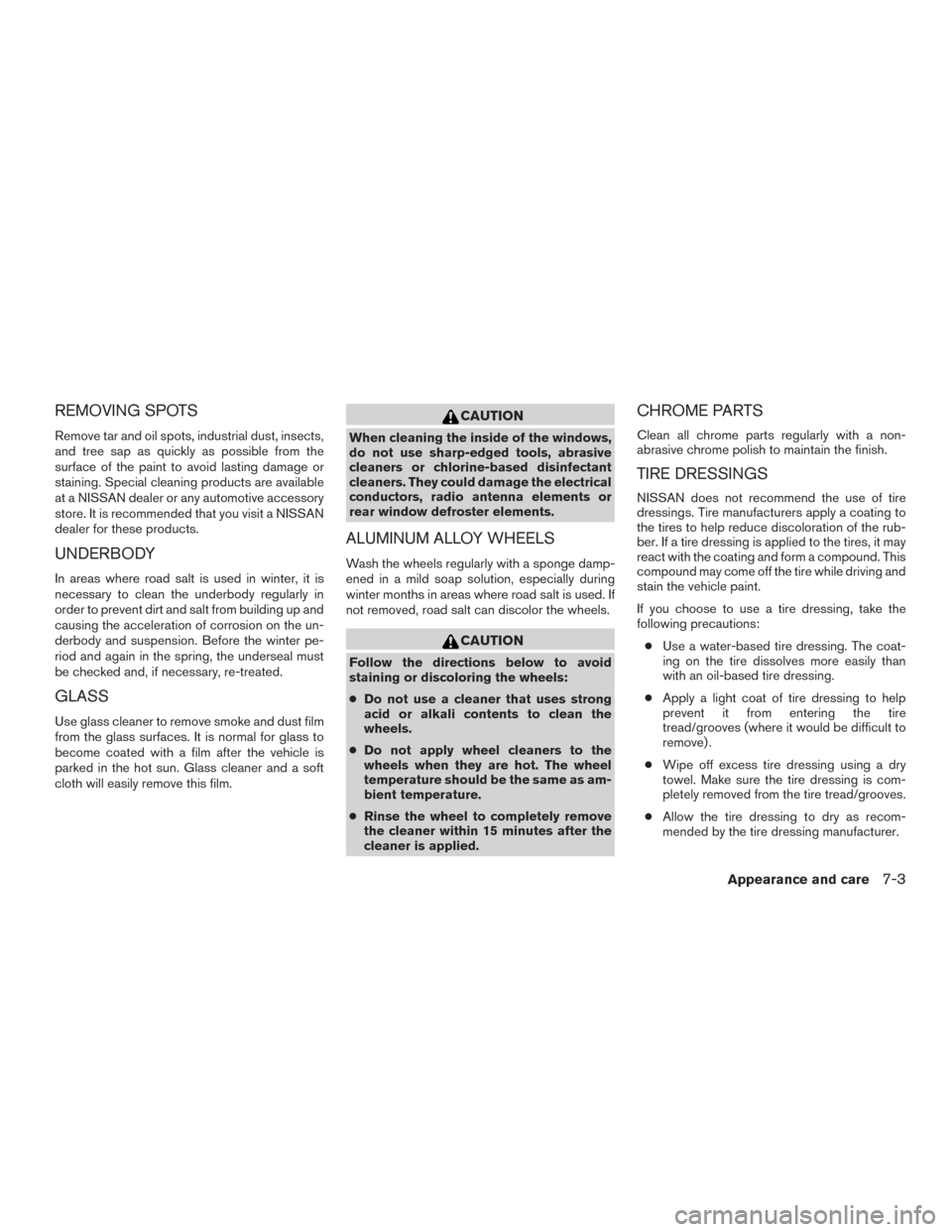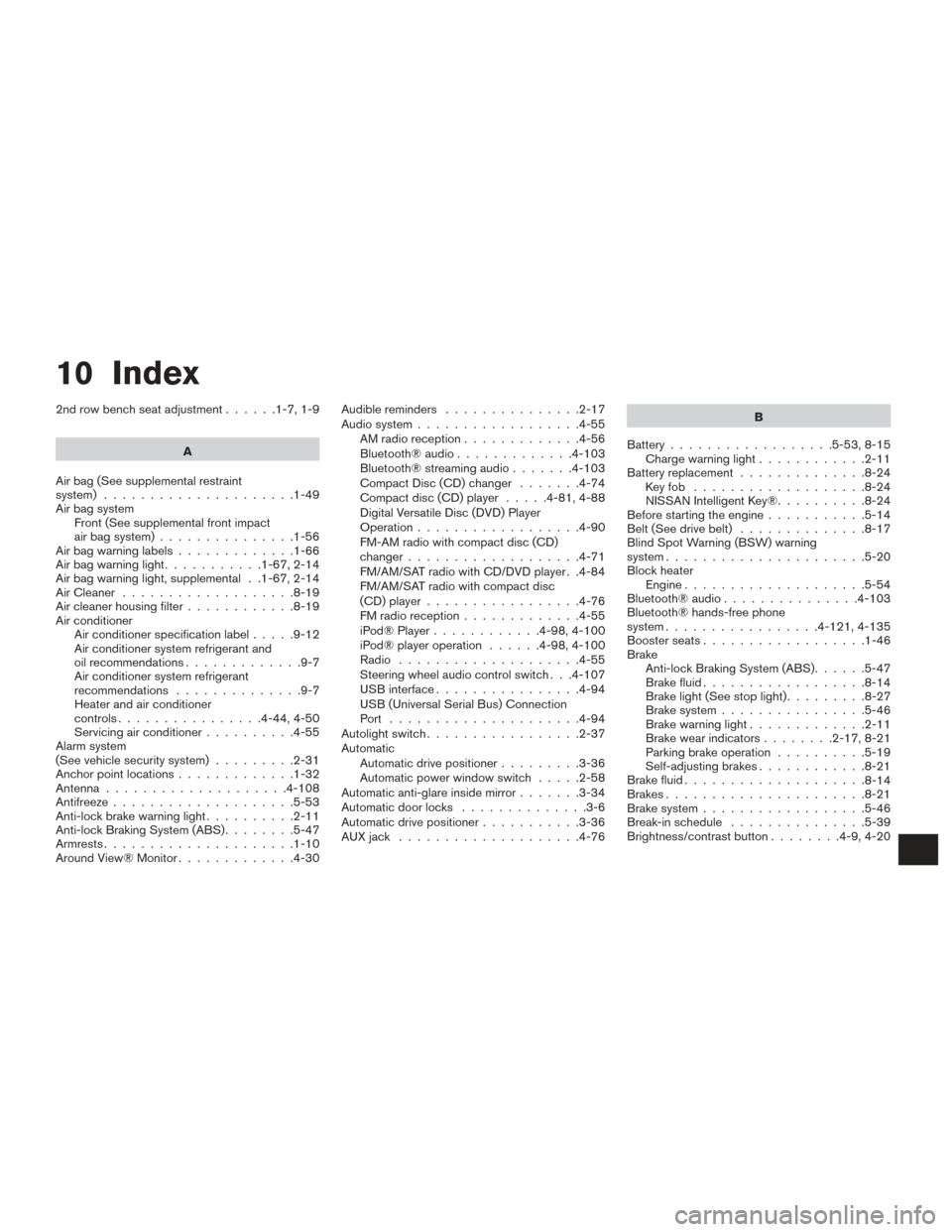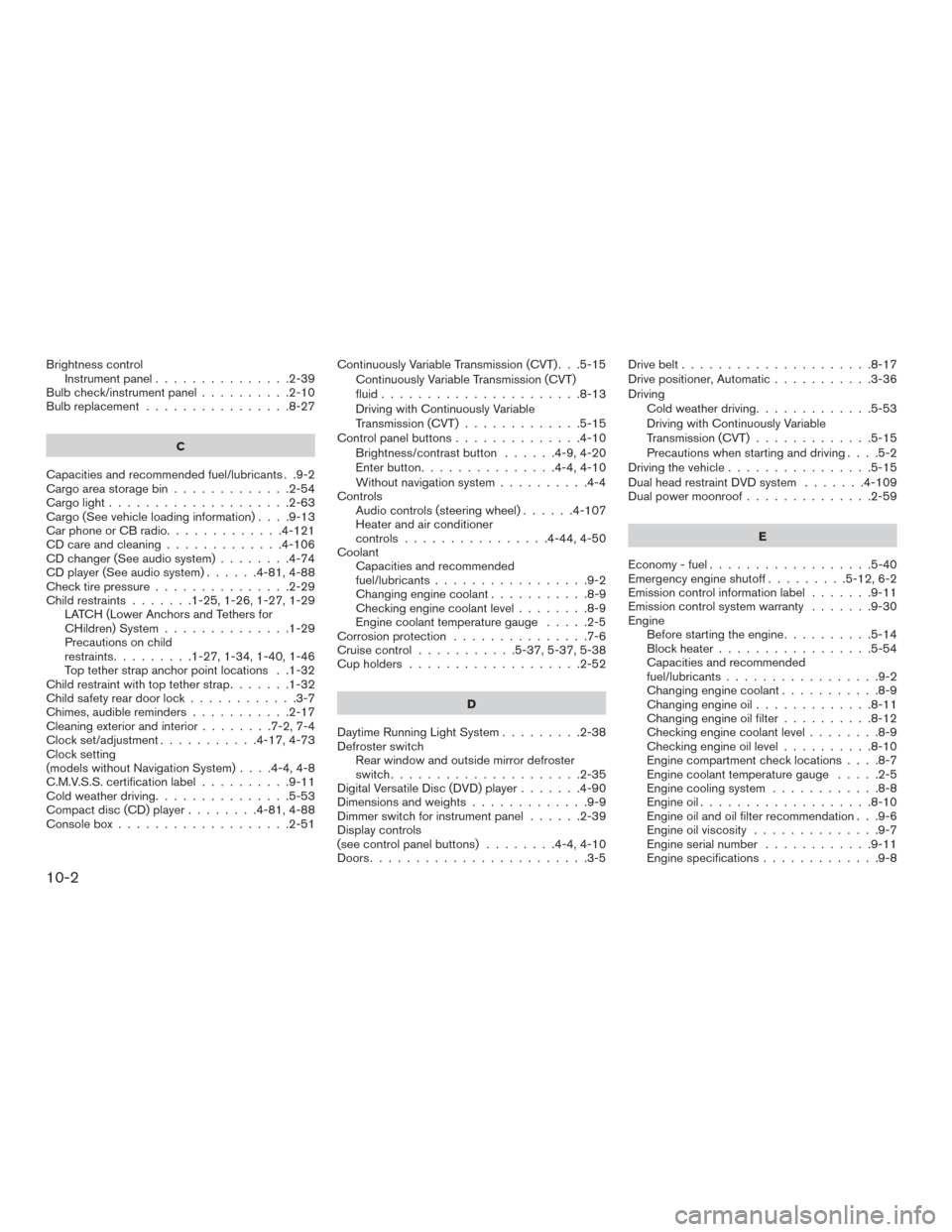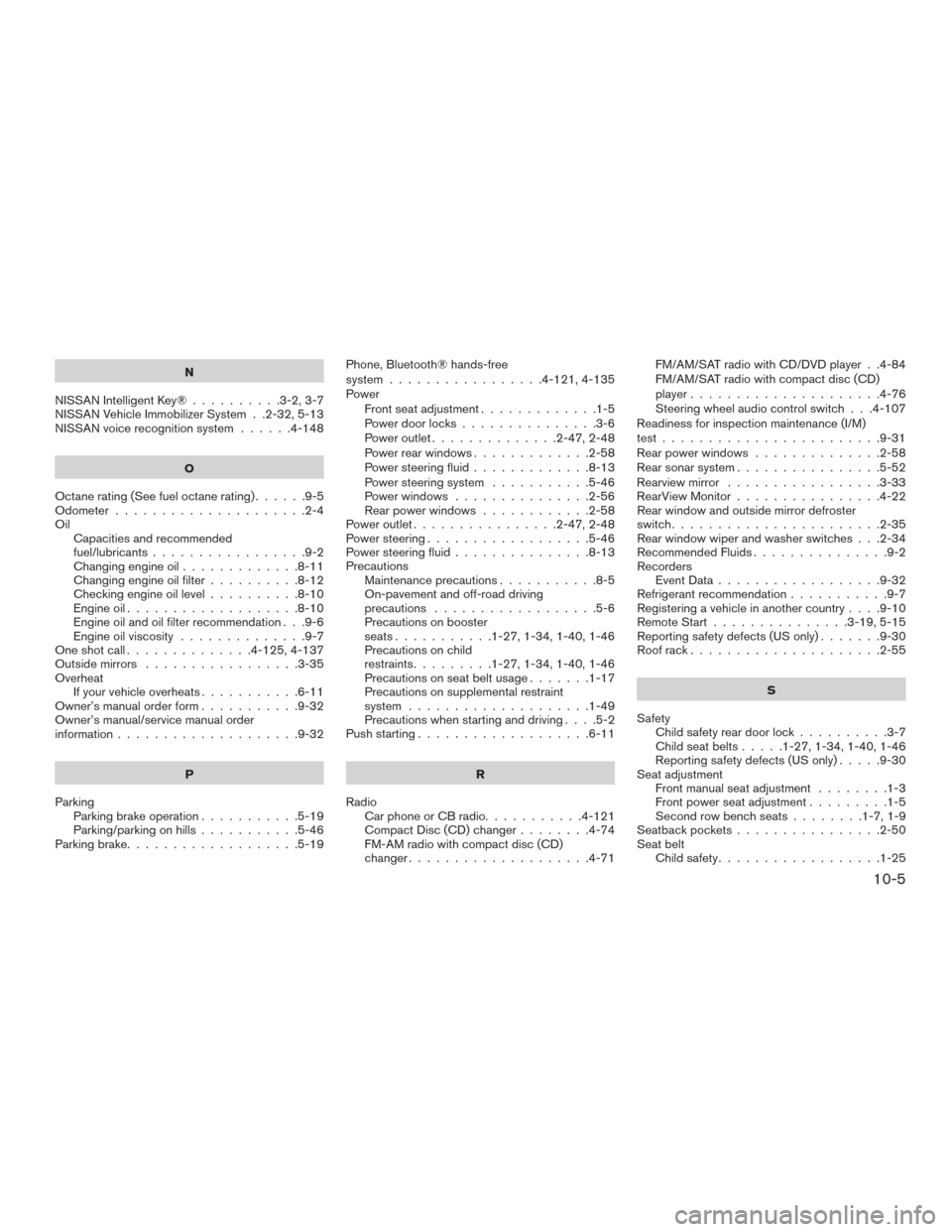2016 NISSAN PATHFINDER radio
[x] Cancel search: radioPage 422 of 540

TIRE PRESSURE MONITORING
SYSTEM (TPMS)
This vehicle is equipped with TPMS. It monitors
tire pressure of all tires except the spare. When
the low tire pressure warning light is lit, and the
“Tire Pressure Low - Add Air” warning appears in
the vehicle information display, one or more of
your tires is significantly under-inflated. If
equipped, the system also displays pressure of
all tires (except the spare tire) on the display
screen by sending a signal from a sensor that is
installed in each wheel. If the vehicle is being
driven with low tire pressure, the TPMS will acti-
vate and warn you of it by the low tire pressure
warning light. This system will activate only when
the vehicle is driven at speeds above 16 mph
(25 km/h). For additional information, refer to
“Warning lights, indicator lights and audible re-
minders” in “Instruments and controls” section
and the “Tire Pressure Monitoring System
(TPMS)” in the “Starting and driving” sections of
this manual.
WARNING
●Radio waves could adversely affect
electric medical equipment. Those who
use a pacemaker should contact the
electric medical equipment manufac-
turer for the possible influences before
use.
● If the low tire pressure warning light
illuminates while driving, avoid sudden
steering maneuvers or abrupt braking,
reduce vehicle speed, pull off the road
to a safe location and stop the vehicle
as soon as possible. Driving with under-
inflated tires may permanently damage
the tires and increase the likelihood of
tire failure. Serious vehicle damage
could occur and may lead to an accident
and could result in serious personal in-
jury. Check the tire pressure for all four
tires. Adjust the tire pressure to the
recommended COLD tire pressure
shown on the Tire and Loading Informa-
tion label to turn the low tire pressure
warning light OFF. If you have a flat tire,
replace it with a spare tire as soon as
possible. ●
Since the spare tire is not equipped with
the TPMS, when a spare tire is mounted
or a wheel is replaced, tire pressure will
not be indicated, the TPMS will not
function and the low tire pressure warn-
ing light will flash for approximately
1 minute. The light will remain on after
1 minute. Have your tires replaced
and/or TPMS system reset as soon as
possible, It is recommended you visit a
NISSAN dealer for these services.
● Replacing tires with those not originally
specified by NISSAN could affect the
proper operation of the TPMS.
● Do not inject any tire liquid or aerosol
tire sealant into the tires, as this may
cause a malfunction of the tire pressure
sensors.
CHANGING A FLAT TIRE
If you have a flat tire, follow the instructions be-
low:
Stopping the vehicle
1. Safely move the vehicle off the road and
away from traffic.
2. Turn on the hazard warning flashers.
FLAT TIRE
In case of emergency6-3
Page 438 of 540

REMOVING SPOTS
Remove tar and oil spots, industrial dust, insects,
and tree sap as quickly as possible from the
surface of the paint to avoid lasting damage or
staining. Special cleaning products are available
at a NISSAN dealer or any automotive accessory
store. It is recommended that you visit a NISSAN
dealer for these products.
UNDERBODY
In areas where road salt is used in winter, it is
necessary to clean the underbody regularly in
order to prevent dirt and salt from building up and
causing the acceleration of corrosion on the un-
derbody and suspension. Before the winter pe-
riod and again in the spring, the underseal must
be checked and, if necessary, re-treated.
GLASS
Use glass cleaner to remove smoke and dust film
from the glass surfaces. It is normal for glass to
become coated with a film after the vehicle is
parked in the hot sun. Glass cleaner and a soft
cloth will easily remove this film.
CAUTION
When cleaning the inside of the windows,
do not use sharp-edged tools, abrasive
cleaners or chlorine-based disinfectant
cleaners. They could damage the electrical
conductors, radio antenna elements or
rear window defroster elements.
ALUMINUM ALLOY WHEELS
Wash the wheels regularly with a sponge damp-
ened in a mild soap solution, especially during
winter months in areas where road salt is used. If
not removed, road salt can discolor the wheels.
CAUTION
Follow the directions below to avoid
staining or discoloring the wheels:
●Do not use a cleaner that uses strong
acid or alkali contents to clean the
wheels.
● Do not apply wheel cleaners to the
wheels when they are hot. The wheel
temperature should be the same as am-
bient temperature.
● Rinse the wheel to completely remove
the cleaner within 15 minutes after the
cleaner is applied.
CHROME PARTS
Clean all chrome parts regularly with a non-
abrasive chrome polish to maintain the finish.
TIRE DRESSINGS
NISSAN does not recommend the use of tire
dressings. Tire manufacturers apply a coating to
the tires to help reduce discoloration of the rub-
ber. If a tire dressing is applied to the tires, it may
react with the coating and form a compound. This
compound may come off the tire while driving and
stain the vehicle paint.
If you choose to use a tire dressing, take the
following precautions:
● Use a water-based tire dressing. The coat-
ing on the tire dissolves more easily than
with an oil-based tire dressing.
● Apply a light coat of tire dressing to help
prevent it from entering the tire
tread/grooves (where it would be difficult to
remove) .
● Wipe off excess tire dressing using a dry
towel. Make sure the tire dressing is com-
pletely removed from the tire tread/grooves.
● Allow the tire dressing to dry as recom-
mended by the tire dressing manufacturer.
Appearance and care7-3
Page 472 of 540

If you have a flat tire, refer to “Flat tire” in
the “In case of emergency” section of this
manual.
TIRE PRESSURE
Tire Pressure Monitoring System
(TPMS)
WARNING
Radio waves could aversely effect
electric medical equipment. Those
who use a pacemaker should con-
tact the electric medical equipment
manufacturer for the possible influ-
ences before use.
This vehicle is equipped with the Tire
Pressure Monitoring System (TPMS) . It
monitors tire pressure of all tires except
the spare. When the low tire pressure
warning light is lit and the Tire Pressure
Low - Add Air warning appears in the
vehicle information display, one or more of
your tires is significantly under-inflated. If
equipped, the system also displays pres-
sure of all tires (except the spare tire) on the display screen by sending a signal
from a sensor that is installed in each
wheel.
The TPMS will activate only when the
vehicle is driven at speeds above 16 mph
(25 km/h). Also, this system may not de-
tect a sudden drop in tire pressure (for
example a flat tire while driving) .
For additional information, refer to “Low
tire pressure warning light” in the “Instru-
ments and controls” section, “Tire Pres-
sure Monitoring System (TPMS)” in the
“Starting and driving” section and “Flat
tire” in the “In case of emergency” section
of this manual.
Tire inflation pressure
Check the tire pressures (including the
spare) often and always prior to long dis-
tance trips. The recommended tire pres-
sure specifications are shown on the
F.M.V.S.S./C.M.V.S.S. certification label
or the Tire and Loading Information label
under the “Cold Tire Pressure” heading.
The Tire and Loading Information label isaffixed to the driver side center pillar. Tire
pressures should be checked regularly
because:
● Most tires naturally lose air over time.
● Tires can lose air suddenly when
driven over potholes or other objects
or if the vehicle strikes a curb while
parking.
The tire pressures should be checked
when the tires are cold. The tires are
considered COLD after the vehicle has
been parked for 3 or more hours, or driven
less than 1 mile (1.6 km) at moderate
speeds.
The TPMS with Easy Fill Tire Alert pro-
vides visual and audible signals outside
the vehicle for inflating the tires to the
recommended COLD tire pressure. For
additional information, refer to “TPMS
with Easy Fill Tire Alert” in the “Starting
and driving” section of this manual.
Incorrect tire pressure, including un-
der inflation, may adversely affect
tire life and vehicle handling.
WHEELS AND TIRES
Maintenance and do-it-yourself8-29
Page 516 of 540

10 Index
2nd row bench seat adjustment......1-7,1-9
A
Air bag (See supplemental restraint
system) .....................1-49
Air bag system Front (See supplemental front impact
air bag system) ...............1-56
Airbagwarninglabels.............1-66
Airbagwarninglight...........1-67,2-14
Air bag warning light, supplemental . .1-67, 2-14
AirCleaner ...................8-19
Air cleaner housing filter ............8-19
Air conditioner Air conditioner specification label .....9-12
Air conditioner system refrigerant and
oil recommendations .............9-7
Air conditioner system refrigerant
recommendations ..............9-7
Heater and air conditioner
controls................4-44,4-50
Servicing air conditioner ..........4-55
Alarm system
(See vehicle security system) .........2-31
Anchor point locations .............1-32
Antenna ....................4-108
Antifreeze ....................5-53
Anti-lock brake warning light ..........2-11
Anti-lock Braking System (ABS) ........5-47
Armrests.....................1-10
Around View® Monitor .............4-30 Audible reminders
...............2-17
Audio system ..................4-55
AMradioreception.............4-56
Bluetooth®audio.............4-103
Bluetooth® streaming audio .......4-103
Compact Disc (CD) changer .......4-74
Compact disc (CD) player .....4-81,4-88
Digital Versatile Disc (DVD) Player
Operation ..................4-90
FM-AM radio with compact disc (CD)
changer ...................4-71
FM/AM/SAT radio with CD/DVD player . .4-84
FM/AM/SAT radio with compact disc
(CD) player .................4-76
FMradioreception.............4-55
iPod® Player ............4-98,4-100
iPod® player operation ......4-98,4-100
Radio ....................4-55
Steering wheel audio control switch . . .4-107
USB interface ................4-94
USB (Universal Serial Bus) Connection
Port .....................4-94
Autolight switch .................2-37
Automatic Automatic drive positioner .........3-36
Automatic power window switch .....2-58
Automatic anti-glare inside mirror .......3-34
Automatic door locks ..............3-6
Automatic drive positioner ...........3-36
AUXjack ....................4-76 B
Battery ..................5-53, 8-15
Charge warning light ............2-11
Battery replacement ..............8-24
Keyfob ...................8-24
NISSAN Intelligent Key® ..........8-24
Before starting the engine ...........5-14
Belt (See drive belt) ..............8-17
Blind Spot Warning (BSW) warning
system......................5-20
Block heater Engine ....................5-54
Bluetooth® audio ...............4-103
Bluetooth® hands-free phone
system.................4- 121, 4-135
Boosterseats..................1-46
Brake Anti-lock Braking System (ABS) ......5-47
Brake fluid ..................8-14
Brakelight(Seestoplight).........8-27
Brake system ................5-46
Brakewarninglight.............2-11
Brakewearindicators........2-17,8-21
Parking brake operation ..........5-19
Self-adjusting brakes ............8-21
Brake fluid ....................
8-14
Brakes ......................8-21
Brake system ..................5-46
Break-inschedule ...............5-39
Brightness/contrast button ........4-9,4-20
Page 517 of 540

Brightness controlInstrument panel ...............2-39
Bulb check/instrument panel ..........2-10
Bulb replacement ................8-27
C
Capacities and recommended fuel/lubricants . .9-2
Cargoareastoragebin.............2-54
Cargolight....................2-63
Cargo(Seevehicleloadinginformation)....9-13
Car phone or CB radio .............4-121
CD care and cleaning .............4-106
CD changer (See audio system) ........4-74
CD player (See audio system) ......4-81,4-88
Check tire pressure ...............2-29
Child restraints .......1-25,1-26,1-27,1-29
LATCH (Lower Anchors and Tethers for
CHildren) System ..............1-29
Precautions on child
restraints.........1-27,1-34,1-40,1-46
Top tether strap anchor point locations . .1-32
Child restraint with top tether strap .......1-32
Child safety rear door lock ............3-7
Chimes, audible reminders ...........2-17
Cleaningexteriorandinterior........7-2,7-4
Clock set/adjustment ...........4-17,4-73
Clock setting
(models without Navigation System) ....4-4,4-8
C.M.V.S.S. certification label ..........9-11
Cold weather driving ...............5-53
Compact disc (CD) player ........4-81,4-88
Consolebox...................2-51 Continuously Variable Transmission (CVT) . . .5-15
Continuously Variable Transmission (CVT)
fluid......................8-13
Driving with Continuously Variable
Transmission (CVT) .............5-15
Control panel buttons ..............4-10
Brightness/contrast button ......4-9,4-20
Enterbutton...............4-4,4-10
Without navigation system ..........4-4
Controls Audio controls (steering wheel) ......4-107
Heater and air conditioner
controls................4-44,4-50
Coolant Capacities and recommended
fuel/lubricants .................9-2
Changingenginecoolant...........8-9
Checking engine coolant level ........8-9
Engine coolant temperature gauge .....2-5
Corrosion protection ...............7-6
Cruisecontrol ...........5-37,5-37,5-38
Cupholders...................2-52
D
Daytime Running Light System .........2-38
Defroster switch Rear window and outside mirror defroster
switch.....................2-35
Digital Versatile Disc (DVD) player .......4-90
Dimensionsandweights.............9-9
Dimmer switch for instrument panel ......2-39
Display controls
(seecontrolpanelbuttons) ........4-4,4-10
Doors ........................3-5 Drive belt
.....................8-17
Drive positioner, Automatic ...........3-36
Driving Cold weather driving .............5-53
Driving with Continuously Variable
Transmission (CVT) .............5-15
Precautions when starting and driving ....5-2
Driving the vehicle ................5-15
Dual head restraint DVD system .......4-109
Dual power moonroof ..............2-59
E
Economy-fuel..................5-40
Emergency engine shutoff .........5-12,6-2
Emission control information label .......9-11
Emission control system warranty .......9-30
Engine Before starting the engine ..........
5-14
Blockheater.................5-54
Capacities and recommended
fuel/lubricants.................9-2
Changing engine coolant ...........8-9
Changingengineoil.............8-11
Changing engine oil filter ..........8-12
Checking engine coolant level ........8-9
Checking engine oil level ..........8-10
Engine compartment check locations ....8-7
Engine coolant temperature gauge .....2-5
Engine cooling system ............8-8
Engineoil...................8-10
Engine oil and oil filter recommendation . . .9-6
Engine oil viscosity ..............9-7
Engine serial number ............9-11
Engine specifications .............9-8
10-2
Page 520 of 540

N
NISSAN Intelligent Key® ..........3-2,3-7
NISSAN Vehicle Immobilizer System . .2-32, 5-13
NISSAN voice recognition system ......4-148
O
Octanerating(Seefueloctanerating)......9-5
Odometer .....................2-4
Oil Capacities and recommended
fuel/lubricants .................9-2
Changing engine oil .............8-11
Changing engine oil filter ..........8-12
Checking engine oil level ..........8-10
Engine oil ...................8-10
Engine oil and oil filter recommendation . . .9-6
Engine oil viscosity ..............9-7
Oneshotcall..............4- 125, 4-137
Outside mirrors .................3-35
Overheat Ifyourvehicleoverheats...........6-11
Owner’s manual order form ...........9-32
Owner’s manual/service manual order
information ....................9-32
P
Parking Parking brake operation ...........5-19
Parking/parking on hills ...........5-46
Parking brake ...................5-19 Phone, Bluetooth® hands-free
system
.................4- 121, 4-135
Power Front seat adjustment .............1-5
Power door locks ...............3-6
Power outlet ..............2-47,2-48
Power rear windows .............2-58
Power steering fluid .............8-13
Power steering system ...........5-46
Power windows ...............2-56
Rear power windows ............2-58
Power outlet ................2-47,2-48
Power steering ..................5-46
Power steering fluid ...............8-13
Precautions Maintenance precautions ...........8-5
On-pavement and off-road driving
precautions ..................5-6
Precautions on booster
seats...........1-27,1-34,1-40,1-46
Precautions on child
restraints .........1-27,1-34,1-40,1-46
Precautions on seat belt usage .......1-17
Precautions on supplemental restraint
system ....................1-49
Precautions when starting and driving ....5-2
Push starting ...................6-11
R
Radio Car phone or CB radio ...........4-121
Compact Disc (CD) changer ........4-74
FM-AM radio with compact disc (CD)
changer ....................4-71 FM/AM/SAT radio with CD/DVD player . .4-84
FM/AM/SAT radio with compact disc (CD)
player
.....................4-76
Steering wheel audio control switch . . .4-107
Readiness for inspection maintenance (I/M)
test ........................9-31
Rear power windows ..............2-58
Rear sonar system ................5-52
Rearview mirror .................3-33
RearView
Monitor ................4-22
Rear window and outside mirror defroster
switch.......................2-35
Rear window wiper and washer switches . . .2-34
Recommended Fluids ...............9-2
Recorders EventData..................9-32
Refrigerant recommendation ...........9-7
Registering a vehicle in another country ....9-10
Remote Start ...............3-19,5-15
Reporting safety defects (US only) .......9-30
Roof rack .....................2-55
S
Safety Child safety rear door lock ..........3-7
Child seat belts .....1-27,1-34,1-40,1-46
Reporting safety defects (US only) .....9-30
Seat adjustment Front manual seat adjustment ........1-3
Front power seat adjustment .........1-5
Secondrowbenchseats........1-7,1-9
Seatbackpockets................2-50
Seat belt Child safety ..................1-25
10-5